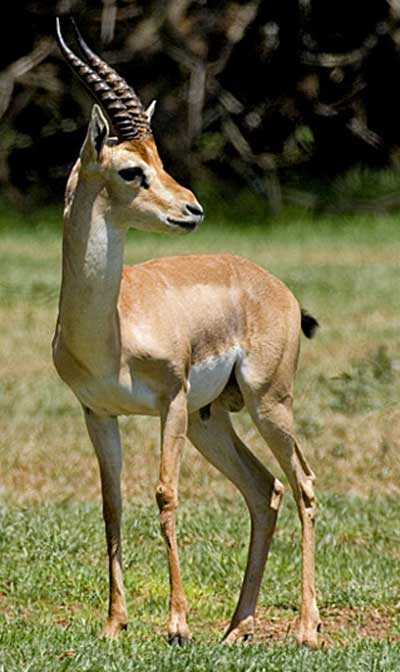Gazella gazella, (*) Cladus: Eukaryota Name Gazella gazella (Pallas, 1766) References * Gazella gazella on Mammal Species of the World. Vernacular names The mountain gazelle (Gazella gazella) is a species of gazelle that is widely but unevenly distributed across the Arabian Peninsula. It inhabits mountains, foothills and coastal plains. Its range coincides closely with that of the acacia trees that grow in these areas. It is mainly a grazing species, though this varies with food availability. It is less well adapted to hot, dry conditions than the Dorcas gazelle which appears to have replaced the Mountain Gazelle through some of its range during the late Holocene in a period of climatic warming. There are less than 15,000 mountain gazelles left within their natural range, more than 10,000 of these being of subspecies G. g. cora, less than 3,000 of the Israeli subspecies, G. g. gazella, less than 1,000 of G. g. farasani, less than 250 of G. g. muscatensis, and 19 of subspecies G. g. acaiae. Mountain gazelles can reach running speeds of up to 80 kilometres per hour (50 mph).[3] In Israel In Israel there are three subspecies: The Israeli gazelle - G. g. gazella. The Israeli gazelle is the most common gazelle in Israel, residing largely in three areas. Its population decreased greatly throughout its natural range in the first part of the 20th century due to poaching[4] and successful breeding of Iranian wolves, but increased thereafter in Israel due to conservation efforts.[4] The southern Golan Heights, which has the largest population of Israeli gazelles, estimated at between 1,500 to 3,000. It is estimated that at the turn of the 21st century, there were 5000 to 6000 Israeli gazelle in the area. The Arava gazelle - G. g. acaiae. The Arava gazelle is in critical danger with only 19 (counting made in 2007 of 17 plus two newborns) gazelle in a closed nature reserve near Yotvata. The merrill gazelle - G. g. merrilli. The merrill gazelle lives in the mountains near Jerusalem. References ^ Grubb, Peter (16 November 2005). "Gazella gazella". In Wilson, Don E., and Reeder, DeeAnn M., eds. Mammal Species of the World: A Taxonomic and Geographic Reference (3rd ed.). Baltimore: Johns Hopkins University Press, 2 vols. (2142 pp.). ISBN 978-0-8018-8221-0. OCLC 62265494. Source: Wikipedia, Wikispecies: All text is available under the terms of the GNU Free Documentation License |
|


